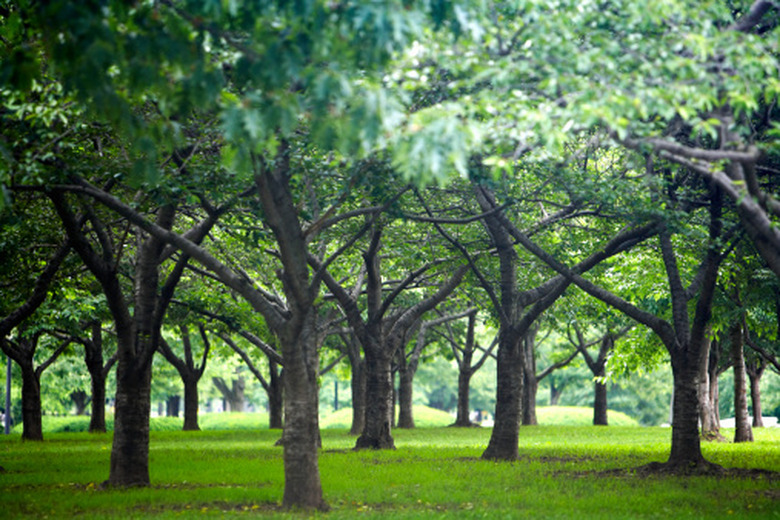What Do All Living Organisms Have In Common?
Although seemingly diverse, living things, or organisms, share certain essential characteristics. The most recent classification system agreed upon by the scientific community places all living things into six kingdoms of life, ranging from the simplest bacteria to modern-day human beings. With recent innovations such as the electron microscope, scientists peered inside cells and began to understand the intracellular processes that defined life.
Composition
Composition
Cells compose all life, performing the functions necessary for an organism to survive in its environment; even the most primitive of life forms, bacteria, consists of a single cell. While peering through a microscope at slices of cork tissue in the late 17th century, scientist Robert Hooke discovered numerous tiny compartments which he coined "cells." After several developments regarding cell structure and function, Robert Virchow compiled a book, "Cellular Pathology," describing the nature of cells in relation to life. He formed three conclusions: cells form the basis of all life, cells beget other cells and cells can exist independent of other cells.
Energy Use
Energy Use
All processes occurring within organisms, whether single-celled or multicellular, expend energy. The method of procuring that energy, however, differs between organisms. Organisms called autotrophs make their own energy while heterotrophs must feed to obtain their energy needs. Autotrophs such as plants and some bacteria produce their own food by converting carbon dioxide and water into sugar with the aid of the sun's energy via photosynthesis. Other autotrophic bacteria use chemicals such as sulfur to make energy in a process called chemosynthesis. The energy organisms need comes in the form of a molecule called ATP, or adenosine triphosphate. Living things make ATP by breaking down glucose.
Response
Response
Organisms use their senses to obtain information from and have the capability of reacting to stimuli in their environments. Even unicellular organisms such as bacteria and seemingly immobile plants can respond to stimuli. Plants such as sunflowers can sense heat and light, so they turn toward the sun's rays. Predators such as cats can track their prey with keen senses of vision, smell and hearing and then hunt them down with superior agility, speed and strength.
Growth
Growth
Living things grow and change through the process of cell division, or mitosis. In organisms composed of more than one cell, mitosis either repairs damaged cells or replace older ones that have died. Additionally, multicellular organisms grow larger in size by increasing the number of cells in their bodies. Unicellular organisms take in nutrients and enlarge. They grow to a certain point and then must divide into two new daughter cells. The process of mitosis takes place in four phases. Certain signals trigger cells to divide. The cell replicates its genetic information, resulting in two exact copies of the gene-bearing structures called chromosomes. Cellular structures separate the chromosome copies, moving them to different sides of the cell. The cell then pinches itself down the middle, creating a new barrier to separate the two new cells.
Reproduction
Reproduction
For a species or organism to continue existing, members of the species must reproduce, either asexually or sexually. Asexual reproduction produces offspring that exactly resemble the parent organism. Certain members in each of the kingdoms of life can reproduce asexually. Bacteria from Kingdoms Archaebacteria and Eubacteria, amoeba of the Kingdom Protista and yeast of Kingdom Fungi use binary fission to simply divide in two, resulting in two identical daughter cells. Worms called planaria can break off a segment that grows into a new organism. Plants such as potatoes form buds which, when cut off and planted, will produce a new potato plant. Sexual reproduction, which allows a mixing of genes from two individuals of a species, evolved from asexual reproduction because the benefits of sex outweigh its costs.
Adaptation
Adaptation
Since the beginning of life, organisms have adapted and evolved to survive according to their environments. Those individuals unable to adapt to changing conditions will die or be unable to pass on much of their genes to the next generation. Many times in the history of the earth, entire species, including many dinosaur groups, have died out when they failed to respond appropriately to environmental changes such as droughts or cooling climates. The environment selects for those individuals best acclimated to live under specific conditions; these creatures have the best selections of mates and will contribute to a greater percentage of descendents.
Cite This Article
MLA
Dinh, Ho-Diep. "What Do All Living Organisms Have In Common?" sciencing.com, https://www.sciencing.com/do-living-organisms-common-8143489/. 11 July 2019.
APA
Dinh, Ho-Diep. (2019, July 11). What Do All Living Organisms Have In Common?. sciencing.com. Retrieved from https://www.sciencing.com/do-living-organisms-common-8143489/
Chicago
Dinh, Ho-Diep. What Do All Living Organisms Have In Common? last modified March 24, 2022. https://www.sciencing.com/do-living-organisms-common-8143489/
